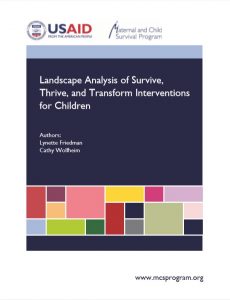
The Sustainable Development Goals, founded on the principle that they are “integrated and indivisible,”1 envision children surviving, thriving, and becoming transformative agents in their communities. The United Nations (UN) Secretary-General’s Global Strategy for Women’s, Children’s and Adolescents’ Health (2016–2030) articulates the strategies needed to achieve the three pillars of survive, thrive, and transform. While many thrive and transform interventions are ongoing, the extent to which they have been implemented in the context of child survival platforms is not known.
The Maternal and Child Survival Program (MCSP), with support from the United States Agency for International Development (USAID), conducted a review on behalf of the Child Health Task Force to explore countries’ experiences adding thrive and transform interventions to platforms used to deliver child survival interventions. The review seeks to map out existing global guidance and understand operational experiences primarily in three African countries, Kenya, Senegal and Zambia, with some examples also presented from Ghana and Rwanda. For each primary country, the experiences are presented in the form of narratives that describe the context, main areas of attention, main sectors in addition to health, coordinating structure, and delivery platforms.
Information was collected through a review of global documents and literature, discussions with carefully targeted key informants at global and regional levels, and discussions with key people in selected countries. Fifty-nine key informants were interviewed, 17 of whom are at either the global or regional level, 37 from the three case study countries (Kenya, Senegal, and Zambia), and five from Ghana and Rwanda. Respondents represented ministries of health, the World Health Organization, UNICEF, USAID, nongovernmental organizations, universities, and other implementing partners.
Interventions and approaches that complement child survival to promote thriving are clearly in the spotlight at both global and country levels. Numerous global initiatives have emerged in recent years, including the UN Secretary-General’s Global Strategy for Women’s, Children’s and Adolescents’ Health, an ongoing “redesign” of child health programming linked in part to the strategic review of child health/Integrated Management of Childhood Illness, and the development and promotion of the Nurturing Care Framework. A substantial number of publications are available that describe the evidence base and support implementation of interventions.
There was clear convergence across the three case study countries on the successes and challenges related to intervention areas, entry points, driving forces, tracking progress, and funding. Intervention areas focused mainly on early childhood development, early childhood education, and nutrition. Associated interventions covered birth registration; water, sanitation, and hygiene; and financial or social protection. Most entry points for action were through existing child survival platforms, of which the thrive interventions are perceived as a natural extension.
The driving forces behind the decision to move forward with adding thrive and transform interventions are inextricably linked to the commitment to develop human capital, the availability of convincing global evidence, and a push/pull from the highest levels of government. This last force translates into political momentum that has been capitalized on and needs to be maintained.
There has been some movement towards tracking progress, however this is perceived as a weak point needing global and national attention. This includes the development, integration, and measurement of indicators, as well as the need to document experiences. Funding is an ongoing challenge, particularly as much of it has been external.
Considering these lessons, a list of recommendations has emerged for consideration by the Child Health Task Force, country partners, and funders as they expand their mandates to include thrive and transform. It is recommended that these partners:
1. Support countries to institute and maintain mechanisms for multisectoral collaboration and coordination that will be sustainable over time.
2. Support efforts to implement the Nurturing Care Framework, which is built on a strong evidence base and is gathering interest and momentum with partners and countries. Note that while doing this, it will be important to keep an eye on interventions beyond early childhood development/early childhood education.
3. Help monitor and improve the quality of care and counseling skills within the health sector.
4. Learn about experiences in additional countries in Africa and other regions.
5. Continue to explore means of delivering or implementing thrive and transform interventions that would complement ongoing work.
6. Support the development and use of global indicators for monitoring process and impact to allow comparison across countries, while supporting countries to institutionalize the use of these indicators across sectors.
7. Ensure that countries can adequately document processes and progress, and share results.